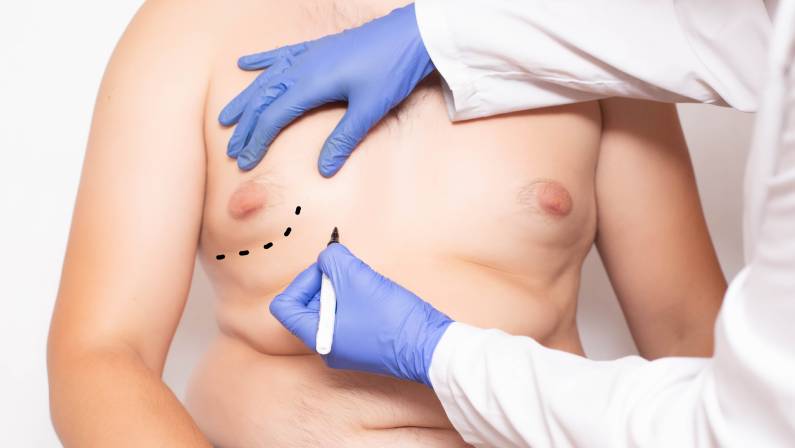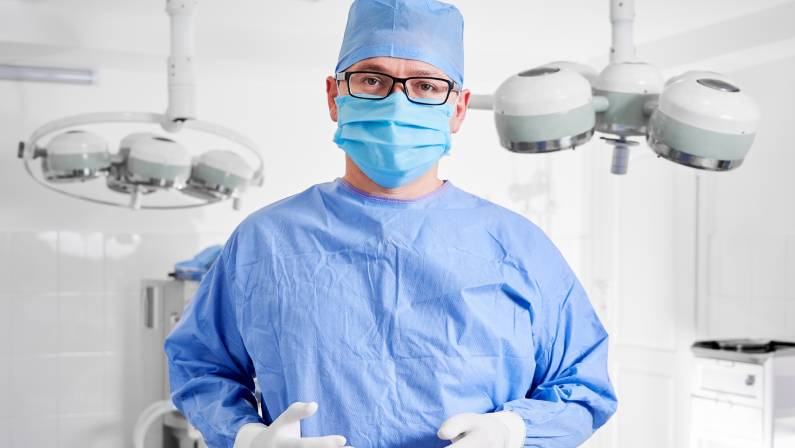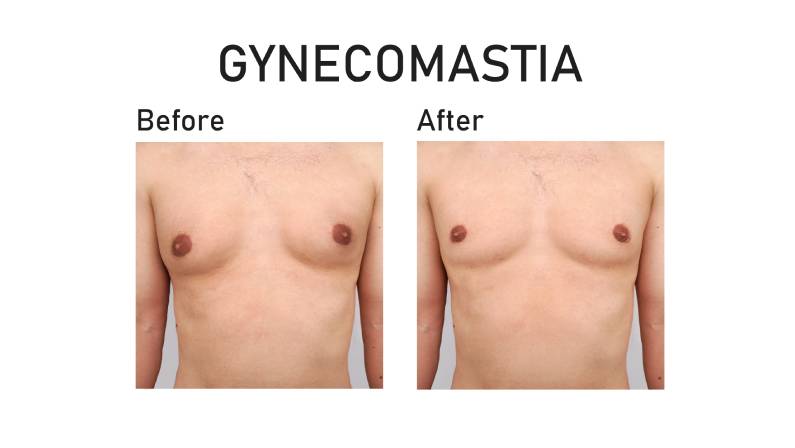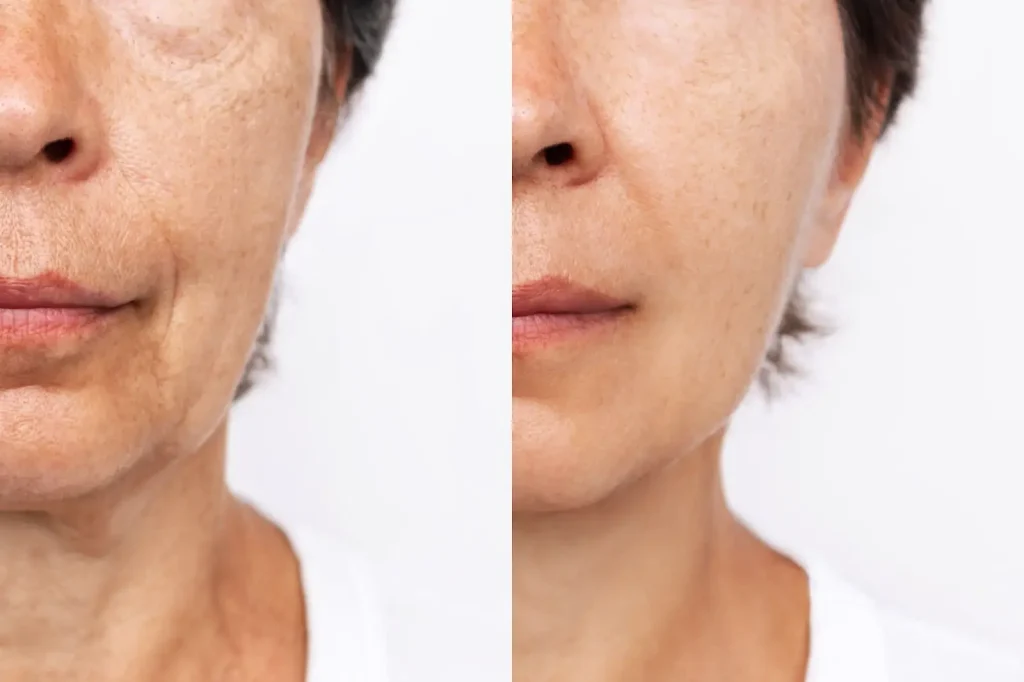Gynecomastia is a condition that affects a significant portion of the male population, causing enlarged breast tissue and often leading to feelings of self-consciousness and discomfort. This is a process where a male breast removal is needed through male chest plastic surgery.
Gyno surgery can be a life-changing option for those dealing with this condition, offering relief from the physical and emotional discomfort associated with enlarged breasts. This surgical procedure involves the removal of excess tissue and reshaping the chest, resulting in a flatter, more masculine appearance.
However, despite the potential benefits, many people are hesitant to undergo gynecomastia surgery due to uncertainty about what the procedure involves, how it works, and what kind of expected results are.
In this article, we’ll explore everything you need to know about gynecomastia surgery, from what it is, where to get gyno surgery, and what to expect before, during, and after the procedure from gynecomastia surgeons.
What is gynecomastia?

Gynecomastia is a medical condition that causes the breast tissue in men to enlarge, resulting in a more feminine-looking chest. It is caused by an imbalance of hormones, specifically an increase in estrogen levels relative to testosterone.
Gynecomastia can occur in males of any age, from infants to adults, and can be caused by various factors, including genetics, medications, hormone imbalances, and obesity.
While gynecomastia is not a severe medical condition, it can cause discomfort and self-consciousness, leading many men to seek treatment options such as gynecomastia surgery.
What are the common causes of gynecomastia?
There are many potential causes of gynecomastia, but one of the most common is hormonal imbalances. Specifically, an increase in estrogen levels relative to testosterone can cause breast tissue to enlarge in men.
This hormonal imbalance can be caused by various factors, including puberty, aging, medications, certain medical conditions, and using steroids or other performance-enhancing drugs.
In some cases, the cause of gynecomastia may be unknown, and it may be called idiopathic gynecomastia.
It’s important to note that while gynecomastia can be caused by severe medical conditions such as liver or kidney disease, in many cases, it is a benign condition that can be effectively treated.
The Commonness of Gynecomastia
The exact prevalence of gynecomastia surgery is not well established, but it is generally considered a relatively standard procedure. According to data from the American Society of Plastic Surgeons, over 25,000 male breast reduction surgeries were performed in the United States in 2020 alone. This number has increased steadily over the past decade, suggesting that more men seek gynecomastia treatment.
It’s worth noting that while gynecomastia surgery is a popular treatment option, it may not be necessary or appropriate for all men with enlarged breast tissue. The decision to undergo surgery should be made in consultation with a qualified healthcare provider.
Who should undergo gynecomastia surgery?
 Good candidates for gynecomastia surgery (male breast reduction surgery) are men with enlarged breast tissue that causes physical discomfort or emotional distress. This may include men who are self-conscious about their chest appearance, experience pain or tenderness in the breast area or have difficulty participating in certain physical activities due to the size of their breasts.
Good candidates for gynecomastia surgery (male breast reduction surgery) are men with enlarged breast tissue that causes physical discomfort or emotional distress. This may include men who are self-conscious about their chest appearance, experience pain or tenderness in the breast area or have difficulty participating in certain physical activities due to the size of their breasts.
Additionally, candidates for gynecomastia surgery should be in good overall health, without any underlying medical conditions that may increase the risks of surgery. They should also have realistic expectations for the procedure’s results and be willing to follow the pre-and post-operative instructions provided by your plastic surgeon.
The Benefits of Gynecomastia Surgery
Chest gynecomastia surgery, also known as male breast reduction surgery, can offer several advantages for men with enlarged breast tissue, including:
- Improved physical comfort: Enlarged breasts can cause physical discomfort, including pain, tenderness, and chafing. Gynecomastia surgery can remove excess breast tissue and reshape the chest, alleviating these symptoms.
- Enhanced self-confidence: Many men with gynecomastia feel self-conscious about their chest appearance, impacting their self-esteem and quality of life. Gynecomastia surgery can help create a flatter, more masculine chest contour, improving self-confidence and body image.
- More clothing options: Men with gynecomastia may avoid certain clothing styles, such as tight-fitting shirts, due to concerns about their breast size. Gynecomastia surgery can allow men to wear a broader range of clothing styles with greater comfort and confidence.
- Long-lasting results: Unlike some non-surgical treatments for gynecomastia, such as hormone therapy, gynecomastia surgery can offer long-lasting results. With proper care and maintenance, the procedure results can be permanent.
It’s important to note that the specific benefits of gynecomastia surgery may vary depending on the individual and their unique circumstances. A qualified healthcare provider can help determine whether gynecomastia surgery is an appropriate treatment option and what specific benefits it may offer.
The Cost of Gynecomastia Surgery
Gynecomastia, also known as enlarged male breasts, is a condition that affects many men. It can cause embarrassment and self-consciousness, leading some to consider surgical options.
Gynecomastia surgery, or male breast reduction surgery, is a standard procedure that involves removing excess breast tissue and fat to achieve a more masculine chest appearance. However, the cost of gynecomastia surgery can vary depending on various factors, such as the surgeon’s experience, the location, and the extent of the procedure.
Gynecomastia surgery costs may include:
Gynecomastia is not an easy surgical process, and it does not come off cheap as well. There are several costs involved in gynecomastia surgery, including:
Anesthesia fees
Anesthesia is essential to any surgical procedure, and gynecomastia surgery is no exception. The type of anesthesia used will depend on the surgeon’s preference and the extent of the process.
Hospital or surgical facility costs
Gynecomastia surgery can be performed in a hospital or an outpatient surgical facility. The cost of the facility will depend on the location and the length of the procedure.
Outpatient facilities are typically less expensive than hospitals, but the type of facility used will depend on the surgeon’s preference and the patient’s needs.
Medical tests
Medical tests such as blood work and imaging studies may be required before the surgery. These tests will add to the overall cost of the procedure. However, these tests are necessary to ensure the patient’s safety during the surgery and to identify any underlying medical conditions that may affect the procedure’s outcome.
Post-surgery garments
Post-surgery garments help reduce swelling and support the chest area after the surgery. These garments are typically not covered by insurance and will add to the overall cost of the procedure.
Prescriptions for medication
Prescriptions for medication to manage pain and prevent infection are an additional expense associated with mens chest plastic surgery. These medications are necessary to ensure the patient’s comfort and safety during recovery.
Does my health insurance cover gynecomastia surgery?
 Whether gynecomastia surgery is covered by health insurance will depend on several factors, such as the extent of the procedure, the patient’s medical history, and the insurance provider’s policy.
Whether gynecomastia surgery is covered by health insurance will depend on several factors, such as the extent of the procedure, the patient’s medical history, and the insurance provider’s policy.
In some cases, male gynecomastia surgery may be considered a cosmetic procedure and not covered by insurance. It’s essential to check with your insurance provider to determine if gynecomastia surgery is covered under your policy.
What to During a Gynecomastia Surgery Consultation
During a plastic surgery for gynecomastia consultation, you can expect to meet with a plastic surgeon specializing in this procedure. The consultation allows the surgeon to evaluate your condition, discuss your medical history and any medications you are taking, and recommend the best treatment for your needs.
Here are some things you can expect during a gynecomastia surgery consultation:
- Physical exam: The surgeon will conduct a physical examination to determine the extent of your condition and whether surgery is necessary.
- Medical history: The surgeon will ask about your medical history, including any medications you are taking, and if you have any pre-existing medical conditions that could impact the procedure or your recovery.
- Personal goals: The surgeon will ask about your goals and expectations for the surgery and any concerns you may have.
- Treatment options: The surgeon will discuss the available treatment options, including surgical and non-surgical options, and recommend the best course of action for your needs.
- Risks and benefits: The surgeon will explain the risks and benefits of the procedure, including potential complications and scarring.
- Preparation: The surgeon will provide instructions on preparing for the procedure, including any medications to avoid and what to do on the day of the surgery.
- Aftercare: The surgeon will discuss postoperative care and what to expect during your recovery, including limitations on activity and follow-up appointments.
Common FAQS to ask your surgeon
Here are some questions you may want to ask your plastic surgeon during a gynecomastia surgery consultation:
-
- How many gynecomastia surgeries have you performed?
- What technique do you recommend for my case?
- What kind of scarring should I expect?
- What are the potential risks and complications of the procedure?
- What kind of anesthesia will be used?
- What kind of post-operative care will be required?
- How long will the recovery process take?
- Are there any limitations or precautions I should take before and after the surgery?
- Can I see before and after photos of your previous patients?
- What kind of results can I expect from the surgery?
Gynecomastia Surgery risks and complications
Here are some potential risks and complications of gynecomastia surgery:
- Bleeding or hematoma
- Infection
- Poor wound healing
- Asymmetry
- Numbness or changes in sensation
- Scarring
- Seroma (accumulation of fluid)
- Contour irregularities
- Allergic reaction to anesthesia
- Deep vein thrombosis or pulmonary embolism (severe but rare)
How to prepare for gynecomastia surgery
 It may sound scary, but preparing for gynecomastia surgery is quite simple.
It may sound scary, but preparing for gynecomastia surgery is quite simple.
Before the procedure, you should:
- Follow your surgeon’s pre-operative instructions, including avoiding certain medications and foods.
- Arrange for transportation to and from the surgery center.
- Arrange for someone to stay with you for at least 24 hours after the surgery.
- Wear comfortable, loose-fitting clothing to the surgery center.
- Unless instructed otherwise, do not eat or drink anything after midnight the night before the surgery.
Gynecomastia Procedure
The process involves removing excess glandular tissue and fat from the breasts, which can be performed using several different techniques. This response will discuss the steps involved in a gynecomastia procedure, including:
Anesthesia
The first step in a gynecomastia procedure is anesthesia. The surgeon will administer either general or local anesthesia with sedation to ensure the patient is comfortable throughout the course. General anesthesia is typically used for more extensive procedures, while local anesthesia with sedation is often used for minor surgeries.
Liposuction technique
Once the patient is under anesthesia, the surgeon will make a small incision in the breast area and insert a thin, hollow tube called a cannula. The cannula is used to suction out excess fat from the breast area. Liposuction is an effective technique for removing excess fat in the breast area, but it is inadequate for removing glandular tissue.
Excision technique
If the patient has significant glandular tissue in the breast area, the surgeon may need to use an excision technique. This involves an incision around the areola and removing the excess glandular tissue. The excision technique is effective for eliminating glandular tissue but is not as effective for removing excess fat.
Combination of liposuction & excision techniques
In many cases, liposuction and excision techniques are used to achieve the best results. The surgeon will first use liposuction to remove excess fat from the breast area and then use an excision technique to remove any remaining glandular tissue. This combination technique allows the surgeon to achieve a more natural-looking result and reduce the risk of postoperative complications.
How long is the recovery period?
The recovery time after gynecomastia surgery varies, but most patients can resume normal activities within 1-2 weeks, with full recovery taking several weeks to a few months. Pain, swelling, and bruising may occur, and patients may need to wear a compression garment for a few weeks to aid healing.
What results should I expect after gynecomastia surgery?
 Gynecomastia surgery can result in a flatter, more contoured chest with improved symmetry and proportion. The extent of improvement varies depending on the severity of the condition, the surgical technique used, and individual factors such as skin elasticity. In some cases, additional surgery or liposuction may be needed to achieve optimal results.
Gynecomastia surgery can result in a flatter, more contoured chest with improved symmetry and proportion. The extent of improvement varies depending on the severity of the condition, the surgical technique used, and individual factors such as skin elasticity. In some cases, additional surgery or liposuction may be needed to achieve optimal results.
When should I see my healthcare provider after gynecomastia surgery?
Patients should see their healthcare provider for a follow-up appointment within a week after gynecomastia or male chest reduction surgery to assess the healing process, remove sutures, and evaluate potential complications. Subsequent meetings may be scheduled to monitor progress and address concerns.
Get a Gynecomastia Surgery from The Best Surgeons
Although it may be possible for some patients to undergo gynecomastia surgery without the help of a qualified surgeon, it is highly recommended that you consult with an experienced plastic surgeon specializing in gynecomastia procedures.
At Dallas Plastic Surgeons, we have a team of experienced and board-certified plastic surgeons specializing in gynecomastia. Our surgeons are committed to providing individualized care and achieving the best possible results for each patient.
Contact us today to schedule your initial consultation if you’re considering gynecomastia surgery.
Last updated on April 26, 2023



